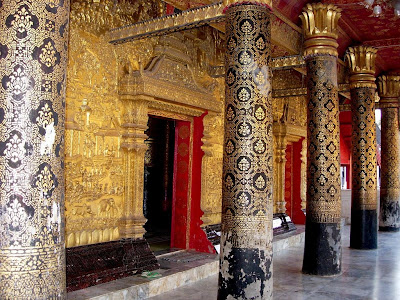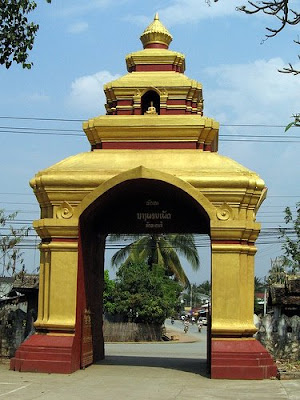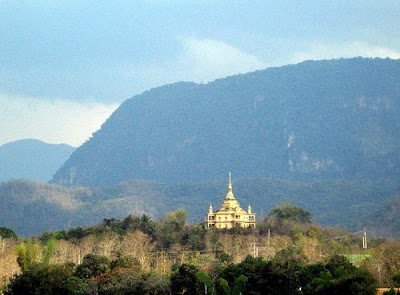Picture by marhas
About the details of Luang Prabangs most important temples you can read at orientalarchitecture.com, which has a lot of pictures.
Until the beginning of the twentieth century all buildings in Luang Prabang were made of wood. The only exception: The temples were built of bricks and mortar. Today only three - Wat Xieng Thong, Wat Pak Khane and Wat Khili - have retained their original structure and decoration.
Each monastery in Luang Prabang is demarcated by a peripheral masonry wall. Doors in the form of prasat - a small, square, tiered and crowned tower, perforated on opposite sides by two large arched bays connected by a continuous passageway allow access to the sanctuary and its building annexes.
Almost always confined to the northern part of the viharn is a building without walls and sometimes on stilts. By token of the shape of its roofing, it resembles a plain sanctuary which is used as a shelter for the pagoda’s great drum. Like the gong, the drum is used for the call to prayers as well as to announce holy days, to mark important events like the Laotian New Year, village festivities, bereavements and festivals. The drum is made from a single piece of tree trunk of about 1 meter in diameter. It is hollowed out and covered at both ends with taut cowhide.
The temples of Luang Prabang are characterized by immense two- or even three-layered roofs covered with flat tiles, sometimes with a change of roof gradient. Another characteristic is the existence of a peripheral nave.
Roof ornamentation, which is very varied in Luang Prabang, is overall characterized by horned ridge-tiles portraying a naga’s upper torso; these may be richly decorated or sometimes reduced to a simple schematic contour. A medial spike, often with three, seven or nine small prasat rises from the top. Depending on the number of spikes, the prasat represent Mount Sinew (the most important mountain in the Buddhist cosmology, with seven annular chains on either side.
Haw Pha Bang: Also: Ho Pha Bang. The Chapel of the Royal Palace, built from 1963 to 1993, lies in the northeastern corner of the ground of the Royal Palace. It has been constructed as the home for the Pha Bang. This is a golden statue (83 cm tall) brought to Luang Prabang in 1359. Then the Khmer king gave the Pha Bang to his son-in-law, the first Lang Xang king Fa Ngum. Read more details an orientalarchitecture.com
This altar is intended to hold the Pha Bang.
Wat Xieng Thong: The "feast for the eyes and the soul" has been built around 1560 by King Setthathirat. It is one of the most important monasteries in Laos. The Lao kings have been coronated here and it was the center of numerous annual festivals honoring the Buddha and various folk spirits. During the 1960s it has been renovated and redecorated. The roof was repaired. The entrance was gilded. The interior and the exterior walls were covered with black, glossy lacquer and decorated with figures and symbols in gold leaf. On the back wall a large flame tree, a tree of life, was set in colored glass mosaics. So it became the temple we admire today.
Where the guests used to arrive from the water way: Stairs leading from the Mekong up to Wat Xieng Thong.
The sim (temple hall): The exterior and the interior are decorated by a rich grandeur. The stenciling on the façade recounts scenes from the jataka and shows images of the punishment of evil-doers. Read a detailed description on orientalarchitecture.com.
The "Dok so fa" with seventeen elements. The more elements this decoration on top of the roof has, the more important is the monastery.
The Tripitaka Library: This chapel from 1828 has many names: Haw Kawng, Haw Trai or Hor Tai. Here the Tripitaka, the 'three baskets' of the Theravada Buddhist canon of scriptures, were stored. Outside colorful glass mosaics show scenes of local life and traditions. Read a detailed description on orientalarchitecture.com.

Picture by marhas
The Red Chapel (Haw Tai Pha Sai-Nyaat): On the outside you see a red stucco inlaid with glass mosaics that illustrate religious and everyday life. The mosaics were added during the restoration in 1957. The original date of the construction of the chapel is not known. The bronze reclining Buddha inside, dating from the 16th century, is one of the most valuable of Lao Buddhist images (see picture). Read more details on orientalarchitecture.com. See also a picture taken in 1973 by Gert Holmertz.

Picture by marhas
The flame tree, the tree of life in mosaic, you find on the back of the sim.
The Carriage House (Hóhng Kép Mien or Hor Latsalat): Built 1962 it contains the funeral chariot of King Sisavang Vong (1885-1959), King of Luang Prabang, 1904-46, and King of Laos, 1946-59. The sculpted and gilded teakwood panels on the exterior show the Lao version of the Ramayana, the Pha Lak Pha Lam. Read more on orientalarchitecture.com. See also this foto taken 2001 by Gert Holmertz.
Seven nagas dominate the royal chariot. It was used to carry the remains of King Sisavang Vong to the field near Wat That Luang for his cremation in April 1961. There are three ornate gilded sandlewood urns, that contained the remains of the king's father (in front) and mother (in the rear); Sisavang Vong's remains are given the central place of honor under the canopy. Read more on orientalarchitecture.com.
Wat Siri Moung Khoung: Also: Wat Si Muang Khun. It has been built in the 18th century.
The Sim of Wat Siri Moung Khoung.
He looks quite wild.
Wat Sop Sickharam: Right next to Wat Sensoukharam. It has been built by King Theng Kham (1479-86).
Wat Sensoukharam: Also: Wat Sene. Sakkarine Road. Built in 1714, surrounded by 11 small stupas.
Wat Sensoukharam has richly decorated windows, on both side you see apsaras standing on beasts. See more picturey on asiaexplorers.com
Wat Mai Souvannaphoumaham: Sisavangvong Road. Across from the Royal Palace, the biggest Buddhist temple in Luang Prabang. Its name means "The new monastery of the golden land". It has been constriucted 1796-1797 by King Anourout. King Manthatourat (1817-1836) has renovated it. During Pimay, the Laotian new year, the Phra Bang is exposed in the temple for three days and the people from Laos come to splash water onto the holy statue for the ceremonial cleansing. Outstanding are the walls of the front verandah. They show scenes from the Ramayana and Buddha's penultimate incarnation. Lacquered columns that are elaborately stenciled. It served as a temple for the royal family and has been the residence of the Pra Sangkharat, the highest Laotian Buddhist dignitary, for longtime. Read more at orientalarchitecture.com.
Gold facade with the central door. Nak Naga figures join the colums to the roof.
Gilded stucco near the entrance.
Stupa and chapels.

Picture by Lorna87. And see also the picture by trekearth.com
Wat Hosiang: Also called Wat Hosian and Wat Hoxian. Adjoining to Wat That. Ho Siang was founded by Khouane Sene Muxa in 1705 or early 1706. The wat was destroyed by a storm in 1900 and rebuilt. The octagonal pillars and the verandas on the northeast and southwest sides of the sim were added in 1952. More details on orientalarchitecture.com
See pictures by laomeow.blogspot.com and by orientalarchitecture.com and wallpaintings by Dany and Maryse
Wat Mahathat: Also: Wat Pha Mahathat or Wat Si Mahatat. Founded by King Say Setthathirath in 1548. The sim collapsed during a storm in 1900 and was rebuilt between 1907 and 1910. Here are also the ashes of the revered Prince Phetsarath, who declared Laos independent in 1945, and Prince Souvanna Phouma, his younger half-brother, who served as prime minister and sought to retain Lao independence in negotiations with the Pathet Lao. More details on orientalarchitecture.comWat Phra Mahathat is one of the most important places in Luang Prabang for the celebration of the Lao New Year. On the third day of Phimai (the day when the deity of the year arrives), the abbots of Wat May, Wat Xieng Thong, Wat Aham and Wat Wisun arrive in a solemn procession to attend a sacred dance of the town's guardian spirits, Phou Nheu and Nha Nheu.
The stairway from Fa Ngum Road shows Thai influence. It reminds of the stairway to Wat Doi Suthep in Chiang Mai.
Picture by Viv and Matt's Travels
See pictures by laomeow.blogspot.com and by orientalarchitecture.com
Wat Aham: This means „The temple of the flourishing heart“, it has been built at the beginning of the ninetenth century and is a centre of meditation.

Entrance to Wat Aham, picture by Hanoi Mark. See more pictures by davieshongkong. See also Banyan Tree and Wat Aham, picture by Esther Kalandjai. And more details by orientalarchitecture.com
Wat Pha Phon Phao:

Picture by Hanoi Mark
Wat Wisunarat: The oldest operating temple in Luang Prabang is also called Wat Visounnalat or Wat Visounlalat. Visoulalat is the name of the King who built it in 874 of Burmese calendar, which is 1512 in international calender. After a fire 1887 set by the black bandits it has been rebuilt from 1896 to 1898. In front of the temple you find the Makmo stupa. It looked like the half shape of the watermelon, so it was called That Makmo. In the temple you see the 835 years old Lao Manuscript, six stones with writing in Lao an Dharma Language. read more.



Jade Buddha at Wat Wisnunarat, pictures by Kleinmatt66

That Makmo (Watermelon Stupa), picture by Kleinmatt66
Wat Saen: Picture by Esther Kalandjai
Santi Chedi This place has many names: Wat Phol Phao, Wat Phom Phao or Wat Phra That Khong Santi Chedi. It lies on top of a hill, from where you have a good view over Luang Prabang. The stupa has been completed in 1988. Inside you find heavenly and apocalyptic paintings.

Picture by annamatic3000. See also pictury by sgtowns.com and frescoes inside by biggworldphotography.com
Wat Long Khun: Before Lao kings were coronated, they spent three days in this wat. See pictures by orientalarchitecture.com and by backpackers-around.com
Pictures by 5 mois de voyage en asie du Sud Est
Wat Nong Sikhounmuang: It has one of the biggest pagodas in Luang Prabang. It has been constructed in the style of vientiane.

Picture by travelling-mirko.de
See pictures by Mai An Hoa, by Alain Travels.
Wat Sen in Luang Prabang, picture by tinsan.net
4 comments:
Very interesting and good insight of what to do/see in Luang Prabang !
http://brohardphotography.blogspot.com
My boyfriend likes to copy watches. When you buy it back, this gorgeous replica watch is amazing. perfect swiss replica iwc watches uk The watch design and function are very fresh and elegant. The quality is relatively perfect.perfect replica IWC pilot watches This copy watch is very special, the quality is very good, the price is very cheap
Luang Prabang
“River Cruising, Cultural, Unique wild Life, Amazing Views, Great people, a once in a lifetime opportunity to explore the undisturbed parts of Laos which borders Thailand, Myanmar, Vietnam and China.”
to get more -http://golaos.com/
Luang Prabang
If you want to travel around Laos, then we offer the best tour services around Laos. We provide the best Mekong River Cruise, Lao Luxury Accommodation, Cultural Tours, Complete Exclusive Packages, and City Tours Service.
to get more - http://golaos.com/
Post a Comment